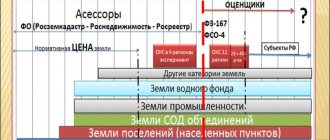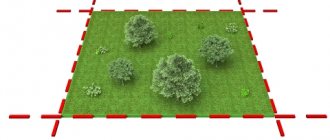Commercial real estate segments:
- • administrative (office) premises,
- • retail premises,
- • warehouses,
- • premises for catering purposes.
Determining the market value of commercial real estate
| Object of assessment | Specifies the type of commercial real estate |
| Date of assessment | The date as of which the cadastral valuation of the object was completed is indicated. In case of deviation from this date, appropriate explanations should be provided in the assessment task. |
| Intended Use of Results | The intended use of the assessment results indicates the determination of the market value of the assessment object to clarify the cadastral value and make changes to the state real estate cadastre. |
| Special assumptions and limiting conditions | This section, along with other assumptions related to a specific assessment object, must include the following special assumptions and restrictions: The appraiser believes that the interval between the date of assessment and the date of preparation of the report is justified by the requirements of Art. 24.19 of the Federal Law “On Valuation Activities in the Russian Federation” dated July 29, 1998 No. 135-FZ. Due to the fact that the date of the assessment is retrospective, the inspection of the assessment object was carried out only to familiarize itself with the assessment object on the ground. |
| Best use analysis: | Best and best use refers to the current use of the subject matter. |
| Rationale for choosing assessment approaches: | The justification for the choice of assessment methods used by the appraiser within the framework of approaches (clause 14 of FSO No. 3) and the justification for refusing to use assessment methods within the framework of approaches (clause 20 of FSO No. 1) must be made with a description of each method. |
| Market value of the valuation object | The market value of the valuation object is expressed in monetary form in the currency of the Russian Federation and is indicated without deducting any payments when making a transaction. If there are deviations, an explanation must be provided for the shift in value relative to market values. |
The assessment of OKS and land plots for challenging the cadastral value is carried out by our specialists in the shortest possible time. You can place an order or get a consultation by phone.
We work daily: from 8.00 to 22.00
Call us at (495) 105-95-30 or write to us by email: This email address is being protected from spambots. To view the address, your browser must have Javascript enabled;
Company office: st. metro station Slavyansky Boulevard st. Davydkovskaya, house 3, building 2, floor 2.
Documents for describing and identifying OKS
- • Title and title documents for the capital construction project;
- • Technical documentation for real estate (technical passport, cadastral passport, extracts from the technical passport, floor plans, explications, etc.).
- • Register of lease agreements and the essential terms of these agreements regarding the size and composition of the rental rate: • Includes/does not include VAT,
- • Includes/does not include operating expenses.
In this case, operating expenses mean all the company’s expenses for operating the CS, utility bills, taxes, as well as insurance costs, including:
- • Payment for services of the management company (utility service).
- • Payment for the services of a security company.
- • Payment for waste removal services.
- • Payment for services for the provision of electricity.
- • Payment for telecommunications and communication services.
- • Payment for water provision services.
- • Payment for services for the provision of household gas.
- • Proportional payment made to pay off rental (tax) payments for the land plot located under real estate by the owner of the real estate.
- • Payment to the insurance company for property insurance.
- • Payment for current repairs of real estate
- • Other payments that may arise under the lease agreement that relate directly to the real estate being valued.
This type of expense does not include depreciation payments.
Documents for description and identification of the Land plot
- • Title and title documents for the land plot under the property being assessed. In the case of renting a land plot, a lease agreement and calculation of current payments for the last reporting period and year are required;
- • Cadastral passport for the land plot.
- • Documents indicating existing encumbrances and restrictions on real estate.
In the case of assessing an unfinished construction project, an investment plan by year is required with breakdowns by type of expenditure, including VAT.
Determination of the real estate market to determine the market value of capital construction projects (CCA) in order to clarify and make changes to the state real estate cadastre
The real estate market is a set of economic relations between market subjects (sellers and buyers) regarding the movement of aggregate or individual rights (services) to real estate and money, which are based on mutual agreement, equivalence and competition.
The real estate market for the subject of assessment is considered perfect and open if it satisfies the following requirements:
- • a sufficient number of economic relations (transactions or offers) are made between market entities, satisfying the principle of sufficiency of the number of analogues,
- • economic relations (transactions or proposals) are confirmed by sources of information that meet the requirements of Federal valuation standards.
The real estate market for the subject of assessment exists in each type (segment) of real estate according to its functional purpose.
The real estate market for the subject of assessment is structured on a territorial basis: local real estate market (within one municipality or settlement), regional real estate market (within a constituent entity of the Russian Federation), federal real estate market (within the Russian Federation).
If there is a perfect and open market for the valuation object, the calculation of market value should be based on the comparative and income approaches.
Comparative approach
The market value of OKS using a comparative approach is determined as the difference between the cost of a single property and the cost of a land plot. A single real estate object means a capital construction project and the area of land required for its functioning.
Selecting an analogue object
An analogue object for the object of evaluation is recognized as an economic relationship (transaction or offer) between subjects of the corresponding real estate market, with a sufficient degree of similarity with the object of evaluation in terms of the main pricing factors:
- • Location;
- • Square.
Number and selection of analogue objects
- • When using the comparative approach, the number of analogue objects cannot be less than the number of factors (elements of comparison) describing the object of assessment, plus one analogue object.
- • The number of factors (elements of comparison) for the analysis of selected analogue objects can be reduced by selecting analogue objects that are completely identical to the object of assessment according to these factors (comparison elements).
- • In any case, the number of analogue objects cannot be less than three.
- • The selection of analogue objects is carried out on the principle of expanding the search area from the local real estate market to the federal real estate market.
- • Information about analogue objects is confirmed by sources of information that meet the requirements of Federal valuation standards.
Adjustments to analogue objects
A cost adjustment of an analogue object based on one of the factors (comparison element) for the valuation object is recognized as a calculated change in the price of an analogue object, based on economic, logical and calculation justifications in accordance with the requirements of Federal Valuation Standards. These adjustments can be calculated based on correlation-statistical models or the paired sales method.
In the process of applying the comparative approach, the following adjustments are generally made to the unit cost of analogues, given taking into account value added tax:
- • rights being assessed;
- • adjustment for the area of the land plot in excess of the area required for the operation of the public housing system;
- • discount from the offer price.
- • adjustment for market conditions (sale period).
- • correction for the state of the object.
- • correction for scale (difference in areas)
- • correction for location.
When all adjustments are made, the results are coordinated using the method of specific weight coefficients. The weighting coefficients for the analogues used should not differ significantly.
Determination of market value
- • The market value of a land plot is determined in accordance with the Methodological recommendations for determining the market value of land plots, approved by order of the Ministry of Property of Russia dated 03/07/2002 No. 568-r, and Methodological recommendations for determining the market value of the right to lease land plots, approved by order of the Ministry of Property of Russia dated 04/10/2003 No. 1102 -R.
- • The market value of a capital construction project is determined by subtracting the market or cadastral value of the land plot for its operation from the cost of a single real estate object. The cadastral indicator is tested for compliance with market value ranges.
Income approach
The market value of OKS is determined by the income approach as the difference between the cost of a single property and the cost of a land plot. If there is additional income from the operation of the land plot (parking), then this territory is part of a single object. If there is no additional income, then the operating area is determined similarly to the area of the comparative approach.
Income approach methods
Within the income approach, two methods must be used:
- • Income capitalization method – in the case of constant income streams from the rental of commercial real estate, for objects that do not require significant investment;
- • Method of discounting cash flows in the case of variable income flows from the rental of commercial real estate, for objects requiring significant investment; for unfinished construction projects.
The market value of an object using the income approach is determined by the sum of cash flows corresponding to income and expenses, reduced to the valuation date using the selected rate and includes the following stages:
Stages
- • Determination of potential gross income;
- • Determination of actual gross income;
- • Determination of operating expenses;
- • Determination of capitalization/discounting ratio;
- • Determination of net operating income;
- • Determination of the cost of reversion (discounted cash flow method);
- • Determination of the final cost of the property;
Determination of PVD
Determination of the potential gross income generated by real estate is based on the analysis and calculation of rental rates without taking into account value added tax. In this case, first of all, data from the register of rental rates as of the valuation date obtained from the Customer is analyzed for compliance with market conditions. If actual rental rates are within the market range, then the weighted average rental rate is taken into account or tenants are segmented according to a selected characteristic. If actual rental rates do not correspond to market values, then it is necessary to calculate the rental rate.
Additional income, for example from parking space, adds up.
Definition of DVD
The determination of actual gross income is determined by taking into account the percentage of occupancy of the property and additional income from the operation of the building. The algorithm for choosing the occupancy percentage is similar to determining rental rates:
- • analysis of the indicator as of the date of assessment of the assessed object;
- • comparison with market conditions;
- • if the actual load complies with market conditions, the actual load is accepted; if it deviates from the market range, the object load is calculated or accepted according to reference data with the condition of justification.
Determination of operating expenses
The choice of the level of operating expenses corresponds to the above algorithm. Costs excluding VAT are accepted for calculation.
During the valuation process using the income approach, operating VAT does not need to be taken into account. Bringing the results of the comparative and income approaches into correspondence leads to the need to charge transaction VAT to the data of the income approach.
Determination of capitalization/discounting rate
The discount/capitalization factor values must be in the range corresponding to the real estate market survey data. The capitalization rate is determined using the market extraction method. When applying a discount factor in the process of implementing the cash flow discounting method, this value is the difference between the capitalization rate and the rate of return.
The cost of reversion is determined taking into account the capitalization rate, and the results are brought to the valuation date using a discount factor.
Determination of market value
- • The final cost of the OCS is the difference between the cost of a single real estate object and the land plot necessary for its operation.
- • Bringing the results of the comparative and income approaches into correspondence leads to the need to charge transaction VAT to the income approach data.
Coordination
Coordination of the obtained results of the market value of the valuation object using various approaches is carried out in accordance with the requirements of the Federal Valuation Standards. The calculation of market value within the framework of the income and comparative approaches is based on the prices of offers, both for the sale and rental of real estate. Accordingly, we can conclude that the information used in the income and comparative approaches is equally market-based. Taking into account the quantity and quality of the initial information, as well as the ability of each approach to take into account the characteristics of the object of assessment and the real estate market conditions, the share of the income and comparative approaches should be parity, i.e. 50% each approach. In other cases, justification for the choice of specific gravity is required.
The final cost must be within a reasonable price range. If there are deviations, an explanation must be provided for the shift in value relative to market values.
Calculation of the market value of OKS using the income approach from the point of view of operating VAT
Including operational VAT
| Index | Calculation procedure | 1st year | 2nd year | 3rd year | 4th year | 5th year |
| Income | A | 1 180 000 | 1 239 000 | 1 300 950 | 1 365 998 | 1 434 297 |
| incl. VAT (output VAT) | A1 = A × 18 / 118 | 180 000 | 189 000 | 198 450 | 208 373 | 218 791 |
| Expenses (transactions not subject to VAT) | B | 100 000 | 105 000 | 110 250 | 115 763 | 121 551 |
| Expenses (transactions subject to VAT), | C | 200 000 | 210 000 | 220 500 | 231 525 | 243 101 |
| including VAT (input VAT) | C1 = C × 18 / 118 | 36 000 | 37 800 | 39 690 | 41 675 | 43 758 |
| Positive cash flow | A | 1 180 000 | 1 239 000 | 1 300 950 | 1 365 998 | 1 434 297 |
| Negative cash flow for expenses | B+C | 336 000 | 352 800 | 370 440 | 388 962 | 408 410 |
| VAT payable to the budget | A1–C1 | 144 000 | 151 200 | 158 760 | 166 698 | 175 033 |
| Net cash flow | A – (B + C) – (A1 – C1) | 700 000 | 735 000 | 771 750 | 810 338 | 850 854 |
| Discount factor | 0,93 | 0,81 | 0,71 | 0,61 | 0,53 | |
| Discounted Cash Flow | 652 753 | 595 992 | 544 167 | 496 848 | 453 644 | |
| Price: | 2 743 404 | |||||
Description of the state procedure
A cadastral valuation is a list of technical and administrative actions to establish the cadastral value of objects on a specific date.
It is carried out using special techniques, taking into account information about transactions on the market, the level of rent, and the profitability of plots.
The appraiser studies and forecasts rent generation depending on the location and quality of the land . When calculating, it is necessary to take into account the improvements made, the level of transport and social infrastructure, and amenities.
The expert has the right to use information from various cadastres, housing and construction standards: coefficients developed by the BTI, authorities, land and architectural committees.
The cadastral value of land plots is determined depending on the territorial location, area, category and permitted use of the site.
Within the city limits, this is the simultaneous determination of the cost of objects en masse, which consists of :
- collecting information;
- dividing the city into zones;
- calculation of the cost of assessment;
- price zoning of the city;
- recording the assessment results.
The result is the establishment of the cost of a plot according to the assessment zone or the size of a typical plot, similar to the price of similar plots on the real estate market.
Officially establishing the cost and recording it in the Register allows you to solve several problems at the same time :
- The state is creating a unified system of taxation of land holdings of the state and private individuals, which allows optimizing the system of calculation and accounting of taxes, filling the budget and forecasting future volumes of tax revenues.
- Regional authorities have the opportunity to rationally use and manage plots of land, distribute real estate, and issue construction permits.
- Individual property owners have the opportunity to count on fair tax assessments, conduct real estate transactions, and make investments.
The cadastral value usually tends to the market level ; when it is carried out, almost all factors that are important in market valuation are taken into account, but it cannot exceed the market value.
How is it carried out?
The procedure begins after the decision to conduct the assessment is made.
Carried out in several stages:
- A list of objects requiring cadastral valuation is being compiled.
- An independent appraiser is selected and a contract is concluded.
- A cadastral valuation is being carried out.
- A report is drawn up, a draft of which must first be submitted for review.
- The report is being reviewed.
- The results of the work of the appraisers are approved.
- The results are entered into the Unified Real Estate Register.
This procedure is preceded by a preparatory stage , during which:
- Information is collected about the climatic, environmental and hydrographic features of the zone.
- Zones are established according to the general plan if urban objects are assessed.
- Plots are classified according to land users and ownership.
- Classification is made according to functional purpose, urban planning value, type of use (residential, public-business or industrial zones).
- Current use is assessed and the direction of assessment zones is predicted.
- Typical areas and assessment zones are established based on market data.
Features of land valuation for various purposes
The assessment of lands for different purposes is based on the comparative method, that is, on comparing information about the dynamics of price changes, any other information about the plots, using different methods.
Lands usually belong to urban or rural settlements, vegetable gardening, horticultural or dacha societies.
If an agricultural plot is located beyond the border of urban and rural settlements , then the income method is applied, that is, the level of capitalization of rental income is determined. Soil fertility, location, and technological properties are determined.
If the land belongs to other categories and is located outside rural and urban settlements , then a cost or income method is used:
- determination of capitalization of estimated rental income;
- accounting for the costs of growing, maintaining or preserving the value of the natural potential of these lands.
Challenging
If you disagree with the cost of the assessment, the owner of the site has the right to challenge it.
To begin with, you can contact the State Register office at the location of the object with a corresponding application.
This organization has a commission to resolve disputes regarding the results of determining the cadastral value. A response may be received within 30 days.
The practice is that this commission rarely makes a decision in favor of the applicant, so you can immediately go to court .
If you receive a refusal to revise the value of the property, you should file a statement of claim with the court. The cadastre departments become defendants in the case.
The established cadastral value does not always express the standard average cost of land or apartment. Each case is individual and has its own characteristics.
The cadastral value usually takes into account everything that is outside the property : its size is influenced by the city, region, and infrastructure.
Dates
The assessment results are entered into the unified State Register after their approval by the local administration.
The results are posted on the Rosreestr website and in print.
They are valid for at least 5 years until the subsequent cadastral valuation, which is carried out once every 3 years, but at least once every 5 years .
During this period, the size of the cadastral value remains unchanged.
Before the end of the 5-year period, the price can only be changed if necessary :
- change the area or boundaries of the site;
- change the type of destination;
- transfer to another category;
- correct any errors found in the documentation used during the assessment.
During this period, the value of the property on the market may also change due to changes in market conditions, which leads to a decrease in the cadastral value.
In addition, the objective characteristics of the site may change as a result of natural factors, for example, floods, earthquakes, landslides, and road construction.
The cadastral value can be changed at the request of the owner by contacting the local office of Rosreestr or in court.
The new value is considered to come into force from the moment the information is entered into the State Property Committee and the Unified State Register of Rights to Real Estate.








